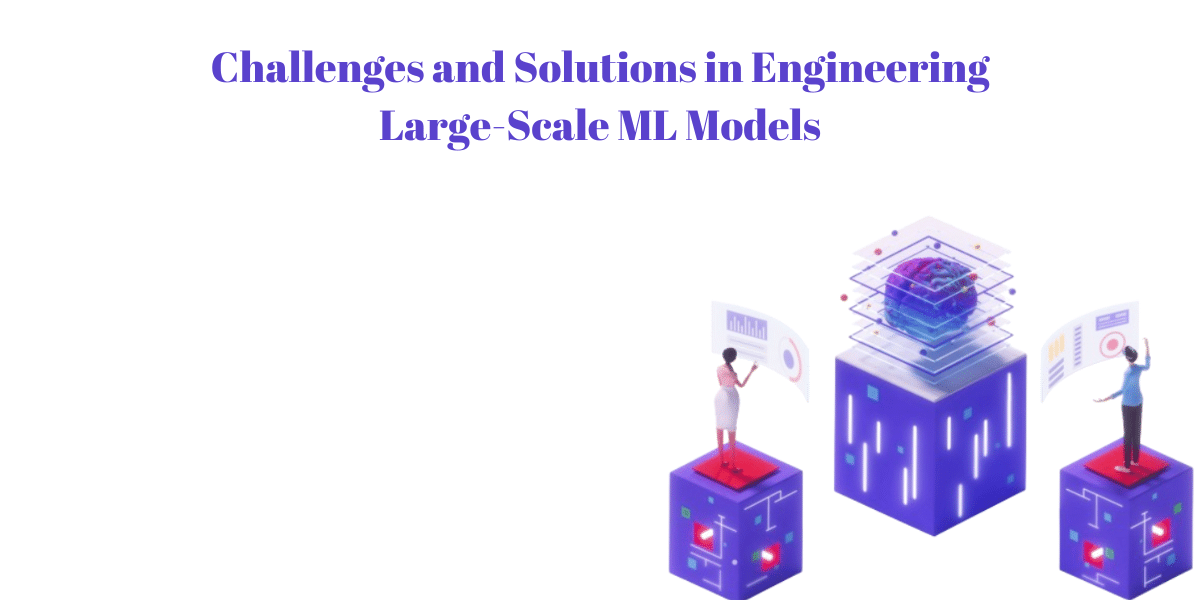The creation of massive machine-learning (ML) models has been recognized as a area where innovation meets issues. As companies increasingly rely on ML to solve complex issues, the ability to scale the ML models becomes an important factor. In this ever-changing environment engineers face a variety of issues ranging from data and computational limitations to management to ethical concerns and environmental impacts.
This chapter focuses on the diverse challenges facing experts in the field of large-scale ML by examining the intricate web of ethical, technical operational, and ethical hurdles. As the demand for high-end ML development solutions increases, knowing how to deal with and overcome these obstacles becomes crucial. This presentation sets the stage for an in-depth study of the intricate processes involved in the development of large-scale ML models. It also highlights the need for innovative solutions that will enable the long-term and effective use of these revolutionary technologies.
The rise of large-scale machine-learning (ML) model has brought into a new age of technology, allowing industries to benefit from the power of huge data sets to solve complex problems. In engineering, the application of ML on a massive scale has been a major engine behind the development of new technologies. This article provides a brief overview of the importance as well as the implications for engineering big-scale ML models.
The large-scale ML models, which are distinguished in their complexity as well as the ability to manage massive data sets and offer unbeatable potential in a wide range of areas including finance, healthcare and even beyond. But, as the size of these ML models grows and the complexity of them increases, so do the problems encountered by engineers. The need for solutions that are scalable is essential to ensure effective design, development and deployment.
Scalability Issues Faced by Engineers in ML Model Development
Scalability is at the top of the challenges faced by engineers working on the development of massive-scale ML models. As the number of datasets grows exponentially and computational requirements increase the traditional pipelines for developing ML models are often ineffective. Engineers are faced with the complexities of scaling algorithms and structures to tackle the demands of more complicated tasks.
Making sure that ML models are scalable is a matter of addressing issues like algorithms’ efficiency, parallelization as well as distributed computation. Engineering professionals navigate the challenges optimization of code deciding on the right hardware, and creating parallel algorithms that make use of the potential in distributed system. The issue of scaling also affects the managing of computational resources as well as the management of workflows, which requires a comprehensive approach to modeling.
Data Management Challenges in Handling Massive Datasets
The foundation of any ML modeling is its data and, in the case of ML models with large scales, managing enormous datasets is a huge issue. Engineers face issues concerning data storage as well as preprocessing and accessibility as data grows in both complexity and size.
The handling of massive data sets requires the development of robust data pipelines that are capable of efficiently ingesting and transforming massive quantities of information. Storage solutions must be able to handle the increasing amount of data, while also ensuring rapid retrieval of data for training and inference. Furthermore, the quality of data and consistency are essential when the volume grows, requiring a meticulous focus on the steps that are preprocessed.
Overcoming Computational Bottlenecks in Large-Scale ML Systems
The demands on computational power of large-scale ML systems pose a huge obstacle for engineers. As ML models get more complex and data volumes grow it becomes important to ensure rapid and cost-effective results.
In order to tackle the challenges of computational computation, you must optimize algorithms, making use of parallel processing and exploring hardware accelerators. Engineers are seeking innovative ways to efficiently distribute work load across several processing units, while minimizing time to train and maximizing resource usage. The selection of suitable hardware architectures, including graphic processing units (GPUs) and Tensor Processing Units (TPUs) play an essential role in reducing the bottlenecks in computation and improving the overall performance of your system.
Balancing Model Complexity and Performance in Engineering
The right balance between complexity of ML model and efficiency is the challenging challenge for engineers working on the creation for large-scale ML models. The desire to create complex ML models that can capture every detail in the data has to be evaluated against the practical concerns of computational efficiency and their real-world applications.
Engineers negotiate the trade-offs of performance and complexity of the ML model using techniques like model pruning, quantization as well as architecture optimization. Making models simpler without sacrificing the power of prediction is a continuous issue, particularly when dealing with huge databases. The best balance is achieved by ensuring that large-scale models of ML do are not just accurate in their predictions but also efficiently and with minimal resource consumption and facilitate their integration in real-life applications.
Challenges of Training Deep Neural Networks on Large Datasets
Learning deep neural networks from huge datasets can pose a challenging array of issues for engineers trying to realize machines’ full capabilities. Although large data sets aid in the durability as well as generalization the massive amount of data can cause issues relating to the computational power and memory requirements as well as convergence.
Engineers are faced with the need for training strategies that are scalable and effectively process large data sets. The difficulty lies not just in developing algorithms that are capable of handling huge amounts of data, but also optimizing the training process in order to reduce the time to convergence. The memory constraints are evident when deep neural networks require large amounts of resources during the process of training, requiring new methods for distributed computing and ML model parallelization.
Addressing Memory Constraints in Scaling ML Models
Memory constraints create a major issue when it comes to scaling ML models of machine learning development services to manage massive databases. As ML models become more complex and the number of datasets increase, researchers have to deal with limitations in memory capacity impacting both the inference and training phases.
Effective memory management is essential to reduce out-of-memory error and enhance the performance of all large-scale models of ML. Techniques like gradient checkpointing that selectively saves intermediate results and memory-efficient neural network architectures are essential elements of the toolkit for engineers. The balance between ML model complexity and memory resources available requires a careful decision-making process to ensure that the model you choose to build is scalable to handle the demands of massive data sets without compromising performance.
Exploring Distributed Computing for Large-Scale ML Workloads
To achieve large-scale machine learning engineers are increasingly turning to distributed computing to meet the massive computational demands of work. Distributed computing provides a highly scalable solution to the problems that arise from training inference, inference, and evaluation of ML models across huge databases.
Distributed frameworks, such as Apache Spark, TensorFlow’s distributed training, and Data Parallelism from PyTorch allow engineers to perform tasks in a parallel manner and distribute them across several GPUs or nodes. However, the move to distributed computing brings the same issues, such as the cost of communication, synchronization issues and considerations regarding fault tolerance. Engineers need to be careful when designing distributed systems in order to optimize efficiency and performance while minimizing bottlenecks that could occur in a distributed computing system.
Strategies for Efficient Feature Engineering in Massive Datasets
The concept of feature engineering is the foundation of the development of ML models using machine learning as well, and when you are dealing with the complexities of large data, it is an intricate issue. Engineers are faced with the challenge of discovering relevant features from vast and varied data sources, and making sure that the features they select add value to the predictive power of the ML model.
Effective feature engineering requires not only deciding on the best features, but also addressing dimensions, dealing with categorical variables and addressing the issue of the degree of. Engineers use techniques like the reduction of dimensionality, one-hot encryption and feature scaling in order to simplify the feature space while not loss of data. As datasets grow as they do, the use of automated method of feature engineering and knowledge specific to the domain becomes essential to identify patterns and connections that are not apparent by relying on manual feature selection.
Handling Unbalanced Data in Large-Scale Machine-Learning
The existence of unbalanced data poses a major hurdle to the creation of large-scale ML models. As the datasets grow and become more diverse, it is possible that the classes within them can become unbalanced, which affects the ability of the model to learn and to generalize.
Engineers should utilize strategies to correct imbalances in data and ensure that the ML model doesn’t favour the majority class. Methods like oversampling, undersampling, as well as the application of data generation techniques that are synthetic can be crucial tools for rebalancing the model. In addition, advanced algorithms like cost-sensitive learning as well as ensemble techniques can be used to reduce the effects of unbalanced data on the performance of ML models. Achieving a balanced approach to imbalanced data sets when using large-scale machine learning will ensure that ML models give accurate and reliable predictions across diverse distributions of classes and enhancing their use in real-world situations.
Optimizing Hyperparameters for Large-Scale Model Training
Hyperparameter optimization is a major issue for engineers as they work on the creation of massive machine learning models. Complex architectures and large datasets increase the impact of hyperparameter selections on the performance of ML models, making the process of optimization both difficult and vital.
Engineers traverse a huge hyperparameter range, which includes batches sizes, learning rates and regularization parameters in search of values that increase the convergence of models, generalization of ML models, and efficiency of computation. Automated methods like Grid search, Random Search and more advanced techniques like Bayesian optimization are essential tools to find optimal configurations for hyperparameters. The balance of exploration and exploitation within the hyperparameter space is crucial particularly for the magnitude and variety of large datasets.
Ensuring Model Robustness and Generalization at Scale
The reliability and generalization model of machine learning development solutions come under greater scrutiny in the context of massive deployments. Engineers are faced with the task of making sure that ML models don’t only work well with training data but also adapt efficiently to data that is not seen which is crucial for the real-world application.
The process of ensuring that models are robust involves methods like dropout, regularization, and adversarial training that improve the capacity of the model to deal with variances and outliers within the data. Engineers also use cross-validation and ensemble techniques to test as well as improve the generalization ability across various types of large data sets. As models grow and become more complex, the need for thorough testing and validation is essential to identify flaws and ensure that the implemented ML models are able to manage a variety of inputs.
Challenges of Model Interpretability in Complex ML Architectures
Understanding the reasoning behind complicated machine learning models is an enormous challenge, especially as their structures grow in complexity. Engineers have to contend with the inherent opaqueness of ML models like deep neural networks. This makes it difficult to grasp the logic behind the reasoning.
The challenge of addressing model interpretation requires a variety of techniques like feature significance analysis and SHAP (Shapley Additive Explanations) values as well as surrogate models. These techniques are designed to reveal insights into the process of making decisions for complex models, helping engineers in understanding the behavior of models and ensuring the transparency of applications that require interpretability for example, healthcare or finance. Finding a balance between ML model complexity and interpretability is vital to build trust and facilitate the use of large-scale ML models within real-world situations.
Mitigating Security Risks in Deploying Large-Scale ML Models
The widespread use of ML models opens up an entirely new realm of security issues for engineers. Since ML models are now integral to crucial decisions-making systems as well as decision making processes protecting them from attack from adversaries and safeguarding sensitive data is a must.
Engineers must find weaknesses in ML model architectures that could be exploited by adversaries. Techniques like adversarial ML model watermarking, model watermarking, as well as secure model’s deployment protocols are vital tools for defending against security risks. In addition, privacy-preserving strategies like federated learning and homomorphic encryption are crucial in securing sensitive data when modeling and inference. The balance between the advantages of massive ML and the necessity for security measures that are robust is crucial to ensure confidence and security when deploying these revolutionary technologies.
Managing Latency and Throughput in Real-Time ML Inference
Inference of machine learning in real-time in large-scale systems poses challenges to regulating the speed and latency. Engineers are faced with the challenge of creating ML models that provide rapid and precise predictions, while also handling a huge quantity of simultaneous requests.
Optimizing latency means improving the efficiency of inference by using methods like the quantization of ML models as well as hardware acceleration and efficient models. Engineers also have to deal with the dilemma of how to balance complexity of the ML model and speed of inference because more complex models might require more computation time. Strategies like load balancing and ML model caching become essential in distributing the requests for inference efficiently across the computing resources. Finding an equilibrium of high performance and low latency is crucial for automated vehicles and online-based recommendation systems as well as real-time detection of fraud which require quick responses to ensure user satisfaction and the efficiency of the system.
Tackling the Carbon Footprint of Large-Scale ML Training
The ever-growing complexity and size model for machine learning comes with an increasing computation demands, causing concerns over the environmental consequences of training models on a large scale. Engineers have to face the challenge of reducing the carbon footprint that comes with the training of resource-intensive models.
To reduce the environmental impact, it is necessary to looking for hardware that is energy efficient, enhancing algorithms to make use of less computational resources and implementing methods of training that focus on sustainability. Techniques like model distillation knowledge transfer and federated training aim to provide comparable performance while using less computational resources. The development of eco-friendly custom machine learning solutions is vital to balance the transformational power of large-scale models and the need to reduce their environmental footprint.
Federated Learning as a Solution for Decentralized Large-Scale Models
In the search to develop models of machine learning that are not centralized Federated learning is an attractive option. Engineers face difficulties in creating models on a network of servers or distributed devices while also ensuring privacy and security of data.
Federated learning allows model training without centralized data aggregation permitting devices to collaborate in learning the global model, but keeping the information local. Engineers need to deal with the complexity of the efficiency of communication models, aggregation of model data, and security protocols that are used in the federated learning system. The method does not only address privacy issues but also permits massive model training on a variety of datasets, without the need for centralization of data.
Handling Updates and Evolving Data in Continuous Learning Systems
Continuous learning systems pose engineers with the task of adapting large-scale machine-learning models to ever-changing environment and data in the course of time. The nature of data that is dynamic demands strategies for model updates as well as retraining and adaptation to ensure that the model remains relevant and efficiency.
Engineers employ techniques like transfers learning and online learning as well as adaptive algorithmic approaches to deal with the issues in continuous learning. These methods allow models to gain knowledge from the new data gradually and modify their parameters according in response to changes in patterns. The delicate balance between stability of models and flexibility is essential for building large-scale machine learning systems that are able to thrive in constantly changing, dynamic circumstances.
Challenges of Model Versioning and Deployment at Scale
As massive ML models of machine learning evolve engineers must deal with the complexity of model deployment and versioning. managing multiple versions of models as well as the ability to deploy updates without disruptions operations are crucial to keeping a stable and flexible ML infrastructure.
Engineers should install version control systems for models, which allow the efficient monitoring of modifications, rollback options and reproducibility. The deployment of new models requires careful planning to reduce interruptions and ensure a smooth transition. The difficulties extend to monitoring the performance of various ML models in production and addressing any problems that could occur during deployment. Model versions and deployment strategies play an important part in the reliability and maintenance in large-scale ML systems.
Coping with Concept Shift and Model Drift on Large-Scale Machine Learning
The use of large-scale ML models presents the issue of managing the concept shift and model drift as time. As the world’s data changes models can experience shifts in the fundamental structures and connections, which requires strategies for adapting and maintaining efficiency.
Engineers can address the issue of ML model drift through the implementation of monitoring systems that can detect shifts in the distribution of input data and trigger ML model updates in response. Techniques such as domain adaptation and transfer learning are valuable tools to mitigate the effects of conceptual shifts. In balancing the need for stability in the ML model and the ability to adjust to changes in the environment is vital when it comes to large-scale ML systems operating within dynamic settings, and ensuring long-term effectiveness and relevance in the long run.
Ethical Considerations in the Development of Massive ML Systems
The creation large-scale machine learning (ML) systems can raise ethical concerns that warrant attention to detail. Engineers have to navigate the ethical landscape in order to make sure that use of massive ML models is in line with the principles of fairness transparency, and accountability.
Ethics-related issues include addressing biases in the training data as well as ensuring fairness in the predictions of models across diverse demographics, as well as revealing the process for making decisions in complicated ML models. Engineers need to employ strategies to minimize biases, abide by ethical guidelines and encourage transparency in the development of ML models. Ethics concerns extend to the impact on society on ML models, which requires the use of a rational approach to tackle the potential negative consequences that could be unintentionally triggered and encourage the responsible use of ML models in various applications.
Regulatory Compliance Challenges for Large-Scale ML Deployments
Large-scale machine-learning deployments operate in a regulatory landscape that presents challenges for engineers. In compliance with data privacy, security and transparency is a must when ML algorithms are integrated in systems and the decision-making process.
Engineers need to stay on top of changing regulations and make sure that ML systems comply with the lawful frameworks, such as GDPR, HIPAA, and industry-specific standards. The key to success is implementing solid data governance procedures, protecting sensitive data, and ensuring transparent decision-making in ML models. The ability to meet regulatory requirements is essential in the responsible and legal implementation of large-scale ML models, encouraging confidence and compliance with current laws and regulations.
Human-AI Collaboration Issues in Scaling ML Models
As machine learning ML models grow in complexity, the interaction among humans with artificial intelligence (AI) systems is an important issue. Engineers face difficulties in creating interfacing tools, interpretability instruments as well as collaborative systems that allow efficient communication and cooperation with humans AI.
In order to ensure that user-friendly interactions are created, it is necessary to design interfaces that show models’ outputs in a clear and useful format. Engineers also have to address the issues of explaining the model’s decisions and incorporate human input into the process of learning. The appropriate balance between automation and human participation is crucial, particularly when it comes to applications where human knowledge is essential for making decisions. Human-AI collaboration issues emphasize the importance of collaboration across disciplines that involves experts in both technical and non-technical areas to improve the acceptance and usability for huge-scale ML systems.
Strategies for Efficient Resource Utilization in Large-Scale ML
Utilizing resources efficiently is a major aspect for engineers who are developing machines that can learn on a large scale. As the demands for computational power and data volumes rise optimizing the utilization of resources becomes essential for sustainability and cost-effectiveness.
Engineers utilize strategies like ML model’s quantization and distributed computing and hardware accelerators to increase the effectiveness in the use of computing resources. Effective data storage and retrieval methods are employed to reduce I/O bottlenecks. Cloud computing platforms provide options for scaling the provisioning of resources according to the fluctuation of workloads. In order to optimize resource utilization, it is necessary to conduct careful monitoring on ML model efficiency, deciding on appropriate hardware configurations and implementing effective algorithms. Utilizing sustainable methods for resource usage is crucial to the sustainability of the economy and the environmental impact of massive ML deployments.
The Key Takeaway
In conclusion, the design of massive machine-learning (ML) models is an extensive array of problems and solutions that are innovative. From scaling problems and the complexity of managing data to ethical concerns as well as regulatory compliance issues, experts must navigate an ever-changing environment that requires constant adaptation.
The quest for efficiency, interpreability, and ethical implementation underscores the changing characteristics of big-scale Machine Learning solutions development. As technology improves, addressing the environmental impact, optimizing efficiency of resource use, and encouraging human-AI cooperation become essential. Case studies that have succeeded highlight the successes of overcoming these challenges, while providing useful information for future projects.
The area of massive ML is at the forefront of revolutionary technological advances, impacting a variety of areas. It’s a testimony to the tenacity and creativity of engineers which is constantly pushing the limits in pursuit of ethical efficient, effective, and powerful huge-scale ML deployments. The path ahead requires an ethical commitment to practices in compliance with regulations, as well as collaboration, which will ensure big-scale ML models are beneficial to society while addressing the difficulties that arise from their creation.











